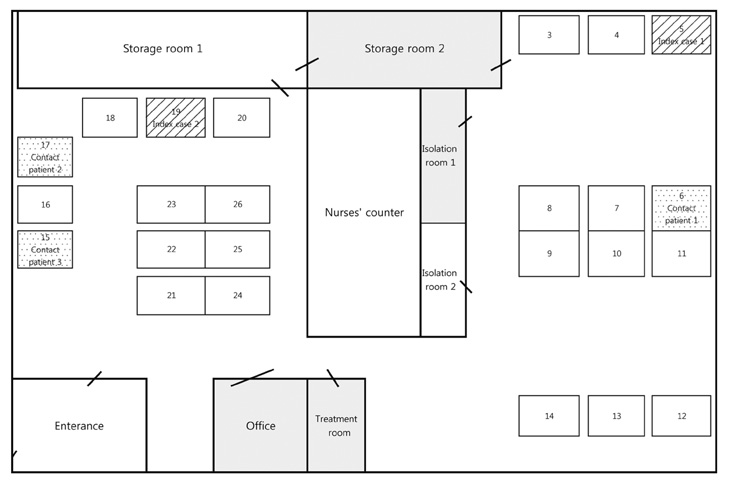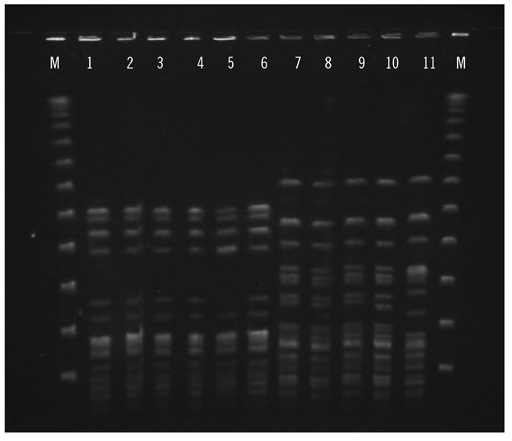Ann Lab Med.
2012 Jan;32(1):82-86. 10.3343/alm.2012.32.1.82.
Characterization of a Vancomycin-resistant Enterococcus faecium Outbreak Caused by 2 Genetically Different Clones at a Neonatal Intensive Care Unit
- Affiliations
-
- 1Department of Laboratory Medicine, Ajou University School of Medicine, Suwon, Korea. weegyo@ajou.ac.kr
- 2Department of Laboratory Medicine, Seran General Hospital, Seoul, Korea.
- 3Department of Hospital Infection Control, Ajou University School of Medicine, Suwon, Korea.
- KMID: 1781443
- DOI: http://doi.org/10.3343/alm.2012.32.1.82
Abstract
- In July 2010, we identified an outbreak of vancomycin-resistant enterococci (VRE) in our 26-bed neonatal intensive care unit. We performed an epidemiological investigation after clinical cultures of 2 neonates were positive for VRE. Identification, susceptibility testing, and molecular characterization were performed. Cultures of 3 surveillance stool samples of inpatients and 5 environmental samples were positive for VRE. All isolates were identified as Enterococcus faecium containing the vanA gene. Two distinct clones were identified by performing pulsed-field gel electrophoresis. The 2 clones exhibited different pulsotypes, but they represented identical Tn1546 types. Two sequence types, ST18 and ST192, were identified among all of the isolates with multilocus sequence typing. Our investigation determined that the outbreak in the neonatal intensive care unit was caused by 2 genetically different clones. The outbreak may have occurred through clonal spread and horizontal transfer of the van gene.
MeSH Terms
-
Anti-Bacterial Agents/pharmacology
Bacterial Proteins/genetics
Bacterial Typing Techniques
Carbon-Oxygen Ligases/genetics
DNA, Bacterial/analysis
*Disease Outbreaks
Electrophoresis, Gel, Pulsed-Field
Enterococcus faecium/drug effects/*genetics/isolation & purification
Feces/microbiology
Genotype
Gram-Positive Bacterial Infections/diagnosis/epidemiology/*microbiology
Humans
Infant, Newborn
Intensive Care Units, Neonatal
Male
Multilocus Sequence Typing
Vancomycin/pharmacology
*Vancomycin Resistance
Figure
Cited by 1 articles
-
Vancomycin-resistant Enterococcus avium Isolated from the Wound of a Patient with Diabetes Mellitus
Young Jin Ko, Hee Sook Shim, Hee-Won Moon, Mina Hur, Yeo-Min Yun
Lab Med Online. 2013;3(2):115-118. doi: 10.3343/lmo.2013.3.2.115.
Reference
-
1. Cetinkaya Y, Falk P, Mayhall CG. Vancomycin-resistant enterococci. Clin Microbiol Rev. 2000. 13:686–707.
Article2. Lee WG, Park IJ, Jin HY, Park MH. Relapse and reacquisition of rectal colonization by vancomycin-resistant Enterococcus faecium after decolonization. Epidemiol Infect. 2010. 138:1449–1453.3. Montecalvo MA, de Lencastre H, Carraher M, Gedris C, Chung M, VanHorn K, et al. Natural history of colonization with vancomycin-resistant Enterococcus faecium. Infect Control Hosp Epidemiol. 1995. 16:680–685.4. Gholizadeh Y, Courvalin P. Acquired and intrinsic glycopeptide resistance in enterococci. Int J Antimicrob Agents. 2000. 16:S1. S11–S17.
Article5. Sherer CR, Sprague BM, Campos JM, Nambiar S, Temple R, Short B, et al. Characterizing vancomycin-resistant enterococci in neonatal intensive care. Emerg Infect Dis. 2005. 11:1470–1472.
Article6. Singh N, Léger MM, Campbell J, Short B, Campos JM. Control of vancomycin-resistant enterococci in the neonatal intensive care unit. Infect Control Hosp Epidemiol. 2005. 26:646–649.
Article7. Ergaz Z, Arad I, Bar-Oz B, Peleg O, Benenson S, Minster N, et al. Elimination of vancomycin-resistant enterococci from a neonatal intensive care unit following an outbreak. J Hosp Infect. 2010. 74:370–376.
Article8. Yüce A, Karaman M, Gülay Z, Yulug N. Vancomycin-resistant enterococci in neonates. Scand J Infect Dis. 2001. 33:803–805.9. Tenover FC, Arbeit RD, Goering RV, Mickelsen PA, Murray BE, Persing DH, et al. Interpreting chromosomal DNA restriction patterns produced by pulsed-field gel electrophoresis: criteria for bacterial strain typing. J Clin Microbiol. 1995. 33:2233–2239.
Article10. Dutka-Malen S, Evers S, Courvalin P. Detection of glycopeptide resistance genotypes and identification to the species level of clinically relevant enterococci by PCR. J Clin Microbiol. 1995. 33:1434.
Article11. Woodford N, Adebiyi AM, Palepou MF, Cookson BD. Diversity of VanA glycopeptide resistance elements in enterococci from humans and nonhuman sources. Antimicrob Agents Chemother. 1998. 42:502–508.
Article12. Homan WL, Tribe D, Poznanski S, Li M, Hogg G, Spalburg E, et al. Multilocus sequence typing scheme for Enterococcus faecium. J Clin Microbiol. 2002. 40:1963–1971.13. Freitas AR, Tedim AP, Novais C, Ruiz-Garbajosa P, Werner G, Laverde-Gomez JA, et al. Global spread of the hyl(Efm) colonization-virulence gene in megaplasmids of the Entercoccus faecium CC17 polyclonal subcluster. Antimicrob Agents Chemother. 2010. 54:2660–2665.14. Galloway-Peña JR, Nallapareddy SR, Arias CA, Elipoulos GM, Murray BE. Analysis of clonality and antibiotic resistance among early clinical isolates of Enterococcus faecium in the United States. J Infect Dis. 2009. 200:1566–1573.15. Bonora MG, Olioso D, Lo Cascio G, Fontana R. Phylogenetic analysis of vancomycin-resistant Enterococcus faecium genotypes associated with outbreaks or sporadic infections in Italy. Microb Drug Resist. 2007. 13:171–177.16. Leavis HL, Bonten MJ, Willems RJ. Identification of high-risk enterococcal clonal complexes: global dispersion and antibiotic resistance. Curr Opin Microbiol. 2006. 9:454–460.
Article17. Klare I, Konstabel C, Mueller-Bertling S, Werner G, Strommenger B, Kettlitz C, et al. Spread of ampicillin/vancomycin-resistant Enterococcus faecium of the epidemic-virulent clonal complex-17 carrying the genes esp and hyl in German hospitals. Eur J Clin Microbiol Infect Dis. 2005. 24:815–825.
- Full Text Links
- Actions
-
Cited
- CITED
-
- Close
- Share
- Similar articles
-
- Vancomycin-resistant Enterococcus faecium isolated from pediatric patients
- Vancomycin-Resistant Enterococcus faecium Meningitis Treated with Linezolid: A Case Report and Review of the Literature
- Molecular Epidemiology of Vancomycin-resistant Enterococci Isolated from Patients in a Neonatal Intensive Care Unit
- Factors Influencing Level of Awareness and Compliance with Vancomycin-Resistant Enterococcus Infection Control among Nurses in Intensive Care Units
- Susceptibility of Fosfomycin against Vancomycin Resistant Enterococci



